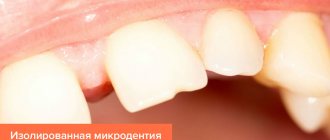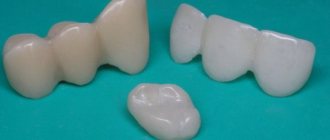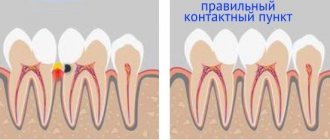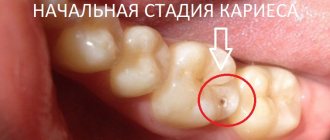Filling of baby teeth should be done in a timely manner to prevent tooth loss.
There is an opinion that baby teeth do not need to be treated, they should be removed immediately. But this is completely misleading. Early removal leads to jaw deformation and incorrect inclination of baby teeth. The permanent bone tissue that appears on the surface will lack a “supporting wall.” After removal, problems with bite formation may occur. And this, in turn, can cause more serious pathologies of the gastrointestinal tract.
But some parents firmly believe that even if, for example, caries is present, nothing bad will happen. When the baby tooth falls out, the problem will solve itself. It is not right. We must not forget that caries is caused by an infection that can migrate throughout the body. In childhood, especially when certain vaccinations are missing, this can cause meningitis, polio, sinusitis, chronic tonsillitis, tonsillitis, and bronchitis.
Filling at an early age will help the bite, speech, normal chewing function to form correctly, and maxillofacial deformities will not develop.
The most common dental problem in childhood is caries; it can occur as early as the first year of life. According to statistics, 13% of children under one year of age have caries. At the age of 6, 78% are already diagnosed with pathology of primary teeth.
And dentistry can be fun: bright colored fillings for the youngest patients
Colored fillings for children have become a real breakthrough in dentistry. Today, many modern dental clinics offer this type of filling. The popularity of such multi-colored fillings is quite understandable, because this is one of the few guaranteed ways to attract the attention of a child and relieve him of groundless fears about dental treatment. Often, this is the only opportunity to force a restless baby to sit in a chair and wait for the doctor to leave a bright spot on the tooth, which can then be shown to friends. Such cheerful multi-colored fillings for little patients will be discussed further in this article.
Contents and release form
The drug is available both in capsules and in special applicators.
The set of stuffable capsules is a set of 40 units of the product, each of which is packaged in an individual mini-container. The set contains eight color shades:
- green;
- orange;
- gold;
- silver;
- blue;
- pink;
- blackberry;
- citric.
The number of capsules of one shade, convenient and quite practical for transportation, storage and use, is 5 units of 0.25 g each.
The product, packaged in the form of applicators, has a dosage of 2 g, in one set there are 100 units of cannulas, this allows you to deliver the drug directly into the cavity as accurately as possible.
Why treat baby teeth if they are going to fall out anyway?
Many parents mistakenly believe that caries and other diseases of baby teeth do not need such close attention, because the teeth will eventually be replaced by permanent ones. In fact, a temporary tooth affected by carious processes becomes an open source for the spread of infection. If the disease is given the opportunity to progress, it will not be limited to just one tooth, but will quickly spread to neighboring ones and will definitely reach the rudiments of permanent teeth. As a result, the child may have serious dental problems in the future. All this suggests that baby teeth are not only possible, but absolutely necessary to be treated, and this should be done when the first signs of a problem appear.
If left untreated, baby teeth can lead to problems with permanent teeth.
If we are talking about the rapid development of caries, then the most common method of treating the pathology is filling. Many mothers and fathers are perplexed why children are given fillings on teeth that will sooner or later fall out. The anxiety of parents is understandable, because they simply do not want to expose their children to unnecessary stress associated with the frightening buzzing of a drill, which they themselves have been afraid of since childhood. But treatment of children’s primary teeth is a prerequisite for the health of permanent ones, and several good reasons can be given for this:
- the roots of baby teeth are in direct contact with the rudiments of permanent teeth. Thus, any even minor problem with a temporary tooth will inevitably affect the condition of the permanent tooth and can even lead to the development of pulpitis,
- if you lose a baby tooth too early, it will certainly affect the state of the bite, may create some difficulties for the eruption of permanent units and even cause a change in the shape of the face,
- also, early loss of primary teeth can provoke certain speech defects,
- the lack of timely treatment for the development of caries can open access to infectious contamination of the body,
- If there is a need for orthodontic treatment, the teeth will still have to be healed, since one of the strict conditions for the installation of any corrective apparatus is the absence of open carious cavities and other dental diseases.
If there is a need for dental treatment, and we are talking about a child, it is important to take a responsible approach to finding a clinic and choosing a pediatric specialist. Treatment methods for primary teeth have their own characteristics and nuances, and only an experienced, qualified dentist will be able to choose the best solution to the existing problem.
Choose only experienced doctors to treat children's teeth
How is a light seal different from a regular one?
In fact, the term “light filling” is more popular among the people, but experts usually use other names: photopolymer, light-curing, heliopolymer are the most common of them. A light filling is a fairly plastic material, and thanks to ultraviolet light it is much easier for a specialist to carry out a filling. This is the main difference between a light filling and a regular one. In addition, you can choose many colors and shades for a light filling, which is why it is so often used in the treatment and restoration of teeth in the smile area. In short, the main advantages of a light filling are reliability, durability and high aesthetics. These qualities make light-based dental fillings one of the most sought after in the dental market.
Multi-colored fillings – both children are delighted and parents are calm
Gone are the days when the dental chair was associated with the terrifying sounds of a working drill, children's tears and screams. Today, dentistry is looking for and finding more effective, safe and completely painless methods of treating dental diseases, as well as ways to interest young patients and help them cope with their fears. Children's multi-colored fillings are an excellent opportunity to attract the baby's attention, arouse his interest and ensure that he sits quietly in the chair until the end of treatment, because he will also be curious to look at the result. Such fillings are created from a material such as compomer - a combination of glass ionomer cement and a hybrid composite1. Just look at the photo below - how interesting they look on children's teeth.
This is what fillings on a child’s teeth look like
“Yes, I myself am delighted with these colored fillings! Well, that's where the cuteness is! My daughter was diagnosed when she was 3 years old and it turned out to be such a cute pink spot on her tooth. It's been three years now and it's holding up great. But recently a hole appeared on another tooth, but since we had already moved to another city by that time, we had to look for a new clinic. This time we chose bright green and glitter. It also holds up great. Eh, if this had happened in my childhood, I wouldn’t have left the dentist.”
Milana_1984, Nizhny Novgorod, from correspondence on the woman.ru forum
So, let's look at the undeniable advantages of children's multi-colored fillings and why they are so popular today:
- fluoride content: this substance makes the enamel of children's teeth stronger and more durable. Thus, the filling also has a therapeutic effect,
- long service life: the strength and reliability of the installed filling is due to the tightness of its adherence to the dental tissues, and all thanks to glass ionomers and other composites included in the material. The service life of such colored fillings is on average 3 years,
- rapid hardening: the filling hardens under the influence of an ultraviolet lamp, and the filling process itself takes very little time. In addition, the composition is placed into the tooth cavity immediately from the capsule, and, accordingly, it does not require any preliminary preparation,
- relatively low cost,
- awakening the baby’s interest in oral care and daily brushing of teeth,
- the ability to promptly notice that the filling has begun to wear off due to its bright color,
- eliminating fear of dental treatment.
Currently, pediatric dentistry offers a variety of colors to choose from: pink, blue, green, yellow, orange, silver and gold, with or without sparkles. All colors are bright and rich. According to reviews, girls usually choose pink and yellow fillings, while boys prefer blue and green fillings.
The ability to choose your own color attracts the child's attention
Types of light seals
Some sources indicate that only anterior teeth can be restored using light-curing composite fillings, but this is incorrect information. Today, such filling is successfully used in all departments, except for the most inaccessible places (for example, “wisdom teeth”). All types of light fillings differ in the composition of the filler, which determines their characteristics.
| Light fillings for teeth | Description | Application area |
| Macro-filled light fillings (light fillings for chewing teeth) | The filler consists of solid large particles (macrophiles). They give the filling strength, but have a rough surface and tend to lose color. | Macrophilic light fillings are usually used on posterior teeth or on the inside of the dentition, where aesthetics are less important. |
| Microfilled light fillings (light fillings for front teeth) | Fillers consisting of small particles. They hold color well, can be polished, but are very fragile. | Mostly used in the smile area. |
| Nanohybrid | They consist of ultra-fine particles that are both durable and aesthetic. | Universal light fillings that can be used in all types of restorations. |
How is filling done?
Treatment with the installation of a colored filling can be divided into several stages. Let's take a closer look at this simple process. So, filling includes the following steps:
- anesthesia - for this purpose, the doctor can give an injection of an anesthetic or, for example, offer an inhalation method of administering an anesthetic,
- after this, the specialist clears the cavity from damaged tissue, for which a drill, laser or sandblasting is usually used,
- then the doctor evaluates the condition of the pulp. If the neurovascular bundle is not damaged, it is disinfected. In the same case, if the pulp is inflamed, the doctor will have to remove it,
- making sure that caries is completely eliminated and the cavity is cleared of bacteria, the dentist protects the nerve with a special gasket,
- filling - the cavity is filled layer by layer with material, which is then exposed to ultraviolet radiation and hardens. After this, the treated tooth is polished and ground.
The photo shows the process of exposure to ultraviolet light on a filling.
In order to eliminate, if possible, factors that can provoke the development of caries in a child, you should carefully monitor what he eats. Try to exclude sweets from his daily diet, since sugar becomes the main cause of tooth decay in childhood. It is equally important to teach your child to brush their teeth every day, and this needs to be done correctly. A pediatric dentist can teach you proper techniques for cleaning enamel from plaque and deposits during a routine examination. If you do not want to subject your child to dental treatment, even with such bright and cheerful fillings, carefully monitor the condition of his mouth and teeth, and also do not forget to show your child to a specialist 3-4 times a year.
- Batyukov N.M., Ivanova G.G., Kurganova I.M. Comparative assessment of the effectiveness of methods of treatment and filling of root canals using modern technologies, 2007.
Preparation
Preliminary preparation for the upcoming filling of the cavity with a filling compound includes the following sequential actions of a specialist:
- cleaning the tooth with a special paste that does not contain fluoride compounds;
- isolation of the working area from adjacent units and the oral cavity;
- choosing a color scheme, as a rule, children actively and happily take part in this process;
- cavity preparation - here the technique of minimally invasive preparation is strictly followed, so that as many healthy, surrounding tissue fragments are preserved as possible;
- cleaning - carefully but thoroughly wash out all residues from the cavity with a stream of water, trying to completely eliminate its contact with blood and salivary fluid.
Excess moisture is removed with dry, warm air of targeted targeted action. A properly prepared area should be slightly damp; - protection of pulp tissue - this manipulation will be required only if the pulp is atypically close; in other clinical situations, padding is not required;
- adhesive - the procedure is performed sequentially and strictly layer by layer with an interval of 40 seconds. This time is quite enough for polymerization. For high-quality setting of the component, standard polymerization devices are used.
The final step is processing and polishing the surface, after which final fluoridation is performed along the edges of the filling, or the entire organ is coated with the product.
Recommendations and precautions
In the course of his work, the doctor must take into account the following factors, ignoring which can harm the patient’s health:
- The material does not tolerate the presence of eugenol, elements of clove oil contained in a number of cement masses. This can negatively affect the result and reduce the quality of polymerization of the composition.
- It is important to eliminate the risk of allergies. Twinkies are a component based on polymers with a reflective color effect.
This external result is not a product of metallic light reflection, but was achieved due to the presence of mica.It is classified as a substance that cannot dissolve. At the same time, mica maintains a level of toxicity below permissible limits; in rare cases, an allergic reaction may occur in a child.
Dental treatment under anesthesia
General anesthesia is an effective way to make the treatment process as comfortable as possible. The child simply falls asleep and wakes up with healthy teeth. Thanks to this, the next time he will not feel afraid before visiting the dental office.
Dental filling for children under anesthesia is preferable in the following situations:
- treatment will last more than an hour;
- it is assumed that the procedure will be painful (when treating distant teeth or advanced caries);
- you need to fill several teeth at a time;
- local anesthesia is not possible (for example, due to allergies);
- it is not possible to place a filling on the child, since any actions in the oral cavity cause a gag reflex;
- unable to overcome panic fear of treatment.
The Natadent dental clinic employs qualified anesthesiologists who will calculate the dose of the drug with maximum accuracy. Thanks to this, the child will wake up immediately after the procedure, and drowsiness will pass very quickly. Modern drugs are completely safe and are used in the treatment of children over 3 years old, so any worries about the consequences are unnecessary.
What is the service life?
Most children's fillings are characterized by durability; they can last until the baby tooth falls out (taking into account proper and regular hygiene procedures). Standard service life is 2-3 years.
In many ways, the reliability of fixation and service life of the filling, as well as the prevention of secondary caries, depend on adhesive systems. For the treatment of primary molars and incisors, adhesive systems of 4-7 generations are most often used.
Result
Placing a filling on a baby tooth allows you to isolate living tissue from external influences and eliminate pain. With the help of fillings, the development of caries and its complications is stopped. On the surface of the filling, the doctor models the relief of the unit, which ensures complete occlusion (closing) of the jaws, restoration of chewing function, and uniform distribution of the load. The units restored by filling are replaced by permanent ones in a natural way, which is optimal for the development of diction and the formation of a healthy bite.
Pediatric dentistry in Perm SC “Apollonia”: fissure sealing
Fissures
- these are folds and depressions on the surface of the enamel. Each person has a different fissure pattern, but plaque tends to get stuck in the folds of tooth enamel.
Pediatric dentistry is rich in various prevention methods. The method of fissure sealing is especially important during the period of change from primary to permanent occlusion.
Microorganisms in the oral cavity, processing plaque, form acid that corrodes the tooth. This is how caries occurs. This can be avoided by sealing the fissures. It is very important to carry out such a procedure in the early stages after tooth eruption, since during this period the enamel is poorly mineralized and, therefore, more susceptible to caries. The sealant mechanically protects the tooth enamel and chemically strengthens the enamel structure by releasing fluoride.
Material requirements
Dental cements must meet a number of criteria. The main requirements include:
- biological compatibility;
- inertness, resistance to exposure to tissue fluids;
- maintaining plasticity, which is necessary for proper modeling of the filling during installation;
- coincidence of the expansion coefficient with the characteristics of the tooth tissues;
- high adhesion;
- rapid hardening when interacting with saliva;
- color stability, availability of a wide palette;
- no shrinkage of cement after it hardens.
In terms of its parameters, a high-quality filling must match the characteristics of the enamel. It must be resistant to loads, abrasion, and have a long service life.
Reviews
The “magic” filling material made it possible not only to minimize the child’s fear of the upcoming treatment and make this procedure more comfortable, but also gave the child the opportunity to take part in the process, forming a habit in him from childhood, to take care of oral health, and not be afraid dentist
If you are familiar with the problems of early treatment of mammary organs and the difficulties associated with it, you can share your opinion about the material presented in this article in the “comments” section. Perhaps your experience will be useful to someone.
If you find an error, please select a piece of text and press Ctrl+Enter.
Tags baby teeth filling fillings
Did you like the article? stay tuned
Previous article
Estelite is a highly aesthetic filling material of a new generation
Next article
About the popularity of braces Prodigy or classic are always in trend










